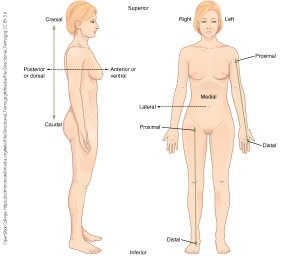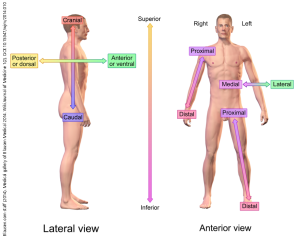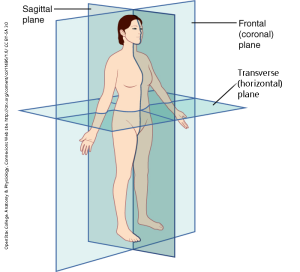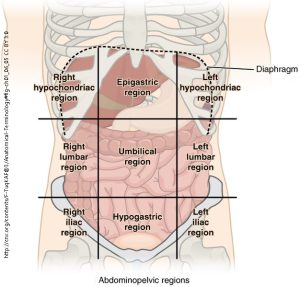Talking About the Human Body
Only [Med Terms] in the Building Episode 2
Anatomical Position

In real life, the human body doesn’t spend a lot of time in any single position, however, when we are talking about the body it is important to have a sort of default position to refer to. Without this, you couldn’t describe the arm as being to the side of the stomach, because it would always depend on how the person is positioned.
This default position is referred to as anatomical position and is demonstrated in the image. This position is useful for describing different parts of the body as well as for defining various body regions.
Similar to the standard position of the body, we use a set of terms to describe directions so everyone is clear about what is being said. If we are simply referencing a part of the body you will find the root for that body part combined with a suffix that means pertaining to, like -al or -ic. Examples include the term spinal, which means pertaining to the spine, or pelvic, which means pertaining to the pelvis.
Directional Terms

If we are describing the location of a part of the body with reference to another, we use specific terms to avoid confusion. These terms may also apply to individual organs as well. For example, we could say that the heart is superior to the stomach, but we could also say that the right atrium of the heart is superior to the right ventricle. Next time you find yourself in front of a mirror, practice using these directional terms. Can you describe your nose with reference to your eyes? How about your ears? How would you describe your hand with reference to your shoulder? Don’t forget to use anatomical position and remember that sometimes more than one term may be used to describe body part locations. For example, your feet are inferior to your knees but your feet are distal to your knees as well.
Planes of Section

One more important way in which we talk about the body is by referring to sections of it, or what we commonly refer to as planes. It’s necessary to know the reference plane of what we are looking at when we examine organs, whether for learning purposes or in clinical settings like when looking at an X-ray. This image illustrates the three cardinal planes of the human body. A fourth plane, not shown in the image, is an oblique plane and refers to any sections not described by one of the three cardinal planes.
Abdominal Regions

The human abdomen is divided up into 9 abdominal regions, tic-tac-toe board style. The regions are centered on the umbilicus, the navel or belly-button.
Standardized Medical Records: The SOAP Note
- The S stands for subjective and is used to describe the patient’s own experiences, views, and feelings, including the reasons why they have sought medical care.
- The O stands for objective and describes information that can be gathered about the patient without requiring the patient’s input. These findings include things like vital signs, physical exam findings, and medical laboratory results.
- The A is for assessment and is the result of an analysis of the subjective and objective information about the patient. Assessment is another way of describing what the healthcare provider believes is wrong with the patient.
- The P stands for plan and covers what will be done to further assess the patient and treat their condition.
Media Attributions
- Unit 2 figure 1 Anatomical Position © OpenStax College is licensed under a CC BY (Attribution) license
- Unit 2 figure 2 Directional References © Blausen.com staff (2014). "Medical gallery of Blausen Medical 2014". WikiJournal of Medicine 1 (2). DOI:10.15347/wjm/2014.010. ISSN 2002-4436 is licensed under a CC BY (Attribution) license
- Unit 2 figure 3 Planes of Section © Connexions OpenStax College. Anatomy & Physiology, Connexions Web site. http://cnx.org/content/col11496/1.6/, Jun 19, 2013. is licensed under a CC BY (Attribution) license
- Unit 2 figure 4 626px-Abdominal_Regions_English © OpenStax, https://cnx.org/contents/FPtK1zmh@8.25:fEI3C8Ot@10 Version 8.25 from the Textbook OpenStax Anatomy and Physiology is licensed under a CC BY (Attribution) license

